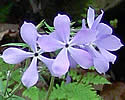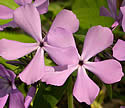Phlox divaricata (Wild Blue Phlox)
| Also known as: | Woodland Phlox, Blue Wood Phlox |
|---|---|
| Genus: | Phlox |
| Family: | Polemoniaceae (Phlox) |
| Life cycle: | perennial |
| Origin: | native |
| Habitat: | part shade, shade; rich woods |
| Bloom season: | April - June |
| Plant height: | 10 to 18 inches |
| Wetland Indicator Status: | GP: FACU MW: FACU NCNE: FACU |
| MN county distribution (click map to enlarge): |  |
| National distribution (click map to enlarge): |  |
Pick an image for a larger view. See the glossary for icon descriptions.
Detailed Information
Flower: 



![[photo of flowers]](/udata/r9ndp23q/blue/wild-blue-phlox-100_4913-t.jpg) A flattish cluster about 3 inches across at the top of the stem. Flowers are ¾ to 1 inch across with 5 petals fused at the base, forming a long, slender tube; hidden inside the tube are 5 stamens and a short style. The petals are narrow at the base; the tip end is wider and round or slightly indented. Color ranges from pale blue to blue-violet to reddish purple, occasionally white.
A flattish cluster about 3 inches across at the top of the stem. Flowers are ¾ to 1 inch across with 5 petals fused at the base, forming a long, slender tube; hidden inside the tube are 5 stamens and a short style. The petals are narrow at the base; the tip end is wider and round or slightly indented. Color ranges from pale blue to blue-violet to reddish purple, occasionally white.
![[photo of calyx]](/udata/r9ndp23q/blue/phlox-divaricata-blue-wood-phlox_0519_113509-t.jpg) At the base of the tube is a slender calyx, purplish and glandular hairy, with 5 long, narrow, spreading teeth.
At the base of the tube is a slender calyx, purplish and glandular hairy, with 5 long, narrow, spreading teeth.
Leaves and stem: 

![[photo of leaves]](/udata/r9ndp23q/blue/wild-blue-phlox_0601_134624-t.jpg) Leaves are 1 to 2 inches long and to ½ inch wide, toothless, tapering to a blunt or pointed tip, rounded at the base, and stalkless. Surfaces are finely hairy, with short fine hairs along the edges. Attachment is opposite, with leaf pairs at right angles to the pair above and below and widely spaced on the stem. Stems are mostly erect, unbranched except in the flowers, and may be somewhat sticky from glandular hairs. On non-flowering plants, the leaves may be wider, rounded at the tip end, and less hairy overall.
Leaves are 1 to 2 inches long and to ½ inch wide, toothless, tapering to a blunt or pointed tip, rounded at the base, and stalkless. Surfaces are finely hairy, with short fine hairs along the edges. Attachment is opposite, with leaf pairs at right angles to the pair above and below and widely spaced on the stem. Stems are mostly erect, unbranched except in the flowers, and may be somewhat sticky from glandular hairs. On non-flowering plants, the leaves may be wider, rounded at the tip end, and less hairy overall.
Fruit: 
Fruit is an oval capsule about 1/6 inch long, shorter than the calyx.
Notes:
The flowers make a nice contrast with the lush green of spring growth in woodlands across the southern half of the state, and does well in a shade garden. There are two recognized varieties (or subspecies, depending on the reference) of Wild Blue Phlox: var. divaricata, found from Illinois eastward, has flowers with petals notched at the tip, and var. laphamii, covering much of the eastern half of North America, including Minnesota, without the notches.
Native Plant Nurseries, Restoration and Landscaping Services ↓
More photos
Photos by K. Chayka taken at Wild River State Park, Chisago County, and in Goodhue County. Photos courtesy Peter M. Dziuk taken in Goodhue County.
Comments
Have you seen this plant in Minnesota, or have any other comments about it?
on: 2011-06-03 14:28:41
Near trails around the visitor center.
on: 2013-06-09 13:09:28
Does anyone know of a MN woodland phlox with larger leaves? I have only seen it pictured in a blog from Bayfield. It grows in full shade and looks like a phlox flower, but wider leaves. Doesn't look like the native phlox you have posted here. Leaves are alternating, serrated and feel a little fuzzy. Is this a non-native?
on: 2013-06-09 16:29:19
Erica, you may have come across dame's rocket, an invasive species often mistaken for a phlox. It has 4 petals rather than 5.
on: 2013-06-09 17:06:22
On June 9, 2013, blooming in profusion along the Oxbow Loop south of Eastman Nature Center. Some scattered plants also along the northern part of Sumac Trail.
on: 2015-05-02 12:54:04
my great grandparents, grandparents, and one day my parents will be buried in Evelyth. I purchased some WildPhlox at a native plant sale for my garden, and found this page... Of course we've had trouble with deer eating the gravesite plants... Would phlox do well?
on: 2015-05-04 03:29:00
Larese, Phlox divaricata is a woodland species and won't likely do well in an open, sunny area like a graveyard. You might try Phlox pilosa instead, which may be better suited to that type of site. I don't know about the deer, though.
on: 2015-05-09 12:37:48
Many scattered clumps of this flower growing in the low wooded areas below the bluffs.
on: 2015-05-25 19:05:23
I am a Minnesotan--and now live over the border in Iowa.--just a little wys. I have many many deer,.and Wild Phlox do well. The deer do not eat them. They are very hungry deer and even eat a good share of things that deer aren't suppose to--but they leave the wild phlox alone.!!! I think that this is valid in Minnesota as well.
on: 2015-06-16 02:10:07
The phlox that I observed at the prairie have a small compound like leaf structure coming out of the leaf axils. Anyone know what this is? Not mentioned in any of my field guides.
on: 2015-07-05 11:39:27
Tom, could it perhaps be prairie phlox (Phlox pillosa), which is far more likely to be found in a prairie than blue wood phlox. :)
on: 2016-05-20 22:01:47
Many clumps of blue phlox divaricata are blooming in the ditches along the gravel road.
on: 2019-05-26 14:49:04
Blue phlox just showed up in my partially shaded rain garden. I thought it was an invasive because I didn't plant it and there was a patch right in the middle where several rains partially submerged it a couple of times this spring. Thank you for your website. I am a contributor.
on: 2020-05-07 16:05:37
Blue phlox many blooming now, with other ephemerals.
on: 2020-05-07 16:56:33
Lots of these blooming in the park today (5/7/2020), particularly in areas where trees were blown down by the tornado in September 2018.
on: 2022-06-01 19:47:06
I just saw this plant blooming in a small, partially shaded garden of natives by my garage. I was surprised to see it because I didn't plant it, and no one near me has native plants. I worried it was an invasive, but after I checked several sources to ID it, I hope it's here to stay. :)







 Wild Blue Phlox plants
Wild Blue Phlox plants Wild Blue Phlox habitat
Wild Blue Phlox habitat reddish-purple flowers
reddish-purple flowers